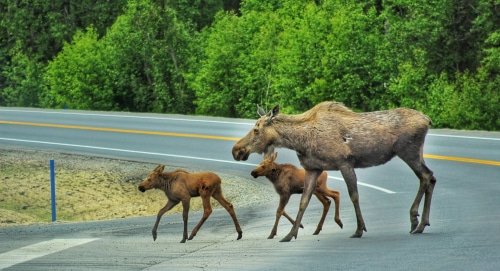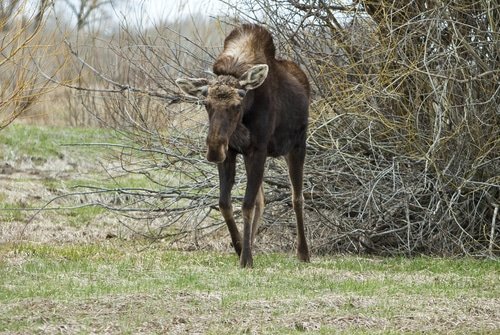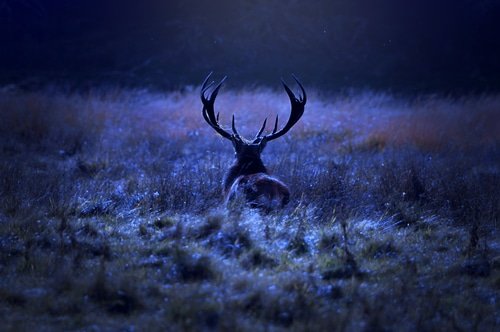The moose undoubtedly comes to mind when you think of the wilderness and its magnificent inhabitants. Moose are a sight to behold with their towering stature, impressive antlers, and graceful movements. These gentle giants have captivated human imagination for centuries, symbolizing the untamed beauty found in forests and mountains. In this blog, we will discuss moose behavior.
Their size alone commands respect, with adult males weighing 1,500 pounds and standing nearly seven feet tall at their shoulders. Beyond their physical grandeur, moose also possess a certain aura of mystery that adds to their allure.
They are predominantly found in the northern regions of North America, Europe, and Asia, where they roam through dense forests and marshy areas. Their ability to adapt to various habitats makes them versatile survivors in subarctic tundras and temperate forests.
Moose are known for being solitary creatures but can also form loose social bonds during certain times of the year. Understanding these magnificent creatures’ behavior deepens our appreciation for them and helps us protect their habitats.
Understanding their behavior for conservation efforts
Conservation efforts are pivotal in preserving our planet’s diverse ecosystems, ensuring that future generations can continue to marvel at the wonders nature has bestowed upon us. To effectively conserve moose populations and their habitats, we must delve into the intricate details of their behavior. By studying communication patterns within moose herds or understanding how they adapt to different environmental conditions, we can gain valuable insights into their needs and vulnerabilities.
Moose herd dynamics are complex systems governed by a delicate balance between social interactions and individual behaviors. Knowing how these majestic creatures establish territories during mating seasons or navigate through vast landscapes allows us to design better conservation strategies.
Furthermore, understanding their feeding habits and migratory patterns helps us identify critical areas for protection and implement measures that ensure the availability of suitable food sources. By comprehending the nuances of moose behavior, we can make informed decisions and take proactive steps toward preserving and preserving the ecosystems they inhabit.
Communication and Social Structure of Moose
Vocalizations: Grunts, Bellows, and Calls
When it comes to expressing themselves, moose have quite the vocal repertoire. From deep grunts to haunting bellows that resonate through dense forests, these magnificent creatures are not shy about making their presence known.
Grunting is often used as a means of communication between moose nearby. At the same time, males predominantly perform the resonant bellowing during the rutting season to attract mates and intimidate rivals.
Additionally, moose emits various calls that serve different purposes. A cow may emit a low “moo” sound to locate her calf or communicate with other members of her family unit, while bulls produce a high-pitched whistle to announce their dominance.
Antler Displays and Physical Postures
Moose are masters at using body language to communicate within their herd. One form of communication is through impressive antler displays and physical postures, especially during the rutting season when male moose vie for dominance.
These majestic creatures engage in dramatic battles using their colossal antlers as weapons against rival bulls. The clashing sounds echo throughout the forest as they push against each other with incredible strength.
Besides antler displays, moose also employ specific body postures to express aggression or submission. An erect posture signifies confidence and assertiveness, while lowered heads or ears laid back indicate submission or deference toward a dominant individual within the group.
Scent Marking and Olfactory Communication
Leaving Invisible Messages in Nature’s Notebook Moose possess a remarkable ability to communicate through scent marking, which plays an integral role in their social interactions.
By urinating or defecating in specific locations, moose leave behind pheromones that convey important messages to others of their kind. Bulls often use this method to mark their territory during the rutting season, warning potential competitors to stay away.
Moreover, moose possess a specialized “metatarsal gland” on their hind legs that releases a strong scent. When they scrape the ground with their hooves and rub this gland against it, they create a unique olfactory calling card for other moose to decipher.
Family Units: Cows, Calves, and Bulls
Strengthening Bonds Within the Herd Moose herd dynamics revolve around family units consisting of cows (females), calves (young moose), and bulls (males).
These family units remain together for an extended period, fostering strong social bonds within the herd. Cows are known to be fiercely protective mothers and defend their calves against any perceived threat.
During the birth season in spring or early summer, cows give birth to precious little calves who quickly learn from their mothers’ behavior. Bulls play a crucial role in these family units during the rutting season when they compete for mating rights and ensure the survival of their genes in future generations.

The Herbivorous Diet: A Feast on Aquatic Plants, Shrubs, and Tree Bark
Moose are the ultimate veggie enthusiast. They have a particular affinity for diverse plant species that comprise their herbivorous diet. Their favorites are aquatic plants like water lilies and pondweed, which they skillfully snatch from the depths with long legs and strong necks.
These aquatic delicacies satiate their hunger and provide vital minerals and nutrients. But don’t underestimate the moose’s love for shrubs!
These towering creatures relish shrubs such as willow, birch, and maple. Their elongated snouts are designed to browse through dense vegetation, plucking leaves precisely.
And when it comes to tree bark, they’re connoisseurs par excellence! Stripping away the outer layers of woody matter allows them to access the nutrient-rich inner cambium layer of trees such as aspen or pine.
Unique Digestive System Adaptations: The Art of Processing Tough Plant Material
To tackle their voracious appetite for fibrous plants, moose have developed an extraordinary digestive system that sets them apart from other herbivores. Within their complex stomach compartments lies a fermentation factory teeming with bacteria and microbes specially equipped to break down tough cellulose fibers found in plant material.
Their journey starts with rapid ingestion through those remarkable snouts into a first stop called the rumen. Symbiotic bacteria tirelessly extract energy from cellulose-rich foods in this massive fermentation vat. But digestion doesn’t end there; next comes regurgitation (yes, you read that right) to re-chew partially fermented food—called cud—to further break it down into smaller particles before sending it back down for final digestion in the lower digestive tract.
Seasonal Variations: A Culinary Adventure Based on Food Availability
Moose are culinary adventurers, adapting their diet to the ever-changing bounty of the seasons. When succulent greens are abundant in summer, moose indulge in an array of tender grasses and high-nutrient aquatic vegetation. As autumn sets in and the leaves turn golden, their focus shifts towards browsing shrubs and trees to accumulate fat reserves for winter.
When winter arrives with its icy grip, moose face a challenge—food scarcity. They rely heavily on their earlier preparations by turning to bark from deciduous trees, woody twigs, and even conifer needles when little else is available.
It’s truly amazing how these resourceful creatures adapt their palates to the ever-shifting gastronomic landscape dictated by Mother Nature. Feed your mind these fascinating insights into moose feeding habits: their diverse herbivorous diet, unique digestive system adaptations, and how they embrace seasonal changes in food availability like seasoned epicureans navigating a culinary adventure!
Reproduction and Mating Behavior of Moose
Rutting Season: The Wild Roller Coaster Ride of Moose Love
Ah, the rutting season, when moose social behavior peaks and the forest echoes with the sounds of love and war. This tantalizing period typically occurs in late summer or early fall, but the exact timing can vary depending on geographic location and climate. The duration?
Oh, it’s a wild ride that lasts for several weeks. During this time, male moose, known as bulls, compete fiercely to win over the hearts (and bodies) of female moose or cows.
Male Dominance Displays: Antler Fights & Mud-Wrestling Extravaganzas
Picture this: two magnificent bull moose standing tall amidst a cloud of testosterone-fueled determination. When it comes to attracting mates during the rutting season, size matters.
These impressive creatures square off against each other with their antlers locked in combat. It’s both breathtaking and terrifying as they clash with incredible force.
But wait, there’s more! If you thought antler fights were the only show-stoppers during rutting season, think again.
Bulls also indulge in another peculiar ritual: wallowing in mud pits. Yes, you heard it right!
They submerge themselves in these muddy arenas to coat their antlers and bodies with mud, producing an earthy aroma that drives the ladies wild. It’s like a spa day meets ancient battle reenactments!
Courtship Rituals: A Symphony of Love
Love is certainly not silent when it comes to moose courtship rituals! As if showcasing their physical prowess isn’t enough, bulls unleash an orchestra of vocalizations to win the hearts of discerning cows.
Their deep grunts reverberate through the forest, echoing their desire across vast distances. But that’s not all; they also use scent marking by rubbing their antlers on trees and urinating in specific locations.
It’s their way of saying, “Hey there, ladies! I’m your dream moose!” If vocalizations and scent-marking aren’t enough to impress the cows, bulls take it further with intense chasing behavior.
Picture a bull moose relentlessly pursuing a cow through thickets and marshes, showcasing his agility and determination in pursuing love. It’s like an elaborate game of tag where only the fittest can keep up.
Birth of Calves: A Mother’s Unyielding Protective Instincts
After the whirlwind romance of rutting season comes the joyous arrival of calves. Female moose undergo an impressive gestation period lasting around eight months before giving birth to one or two adorable little ones. When the time is right, these mothers retreat to secluded areas within dense vegetation to bring their newborns into the world.
Once born, calves experience an immediate bond with their mothers as they navigate a world of dangers lurking behind every tree trunk. The mother’s protective instincts kick into high gear as she shields her young from predators such as wolves and bears.
She constantly keeps watch while teaching her offspring essential survival skills like foraging for food and identifying potential threats. In this delicate dance between life and death, moose social behavior takes on a protective coat of love and resilience that ensures future generations thrive amidst nature’s challenges.
And so concludes our exploration into the intriguing realm of moose reproduction and mating behavior – a wild journey filled with clashes, vocal serenades, playful mud baths, tender courtship rituals, and unwavering maternal devotion. Nature truly knows how to put on a grand spectacle!
Movements and Home Range of Moose
Migratory Patterns Based on Seasonal Changes in Food Availability
When finding food, moose are not afraid to hit the road, or should I say the trail? These magnificent creatures have a knack for migrating based on the availability of their favorite munchies. During the warmer months, when fresh vegetation is abundant, they move towards open meadows and wetlands.
Here, they can feast upon aquatic plants like water lilies and sedges that grow abundantly near lakes and rivers. However, as winter approaches and snow covers the ground, these resourceful animals move towards forests with shrubs and tree bark that can sustain them through the cold months.
Territorial Behavior Among Bulls During Rutting Season
Ah, it’s rutting season! It’s that time of year when love is in the air for moose (or at least for the males!). Bulls engage in fierce territorial behavior during this period as they compete for the attention of receptive females.
Picture this: two massive antlered males facing off against each other in a clash of dominance. They lock antlers and push with all their might to establish superiority.
The winner earns his right to mate with selected cows within his territory. But don’t be fooled by this macho display; these battles are more about posturing than causing real harm.
It’s often just an elaborate showmanship to impress potential mates. Bulls will sometimes roll around in mud pits beforehand to enhance their appearance and intimidate competitors – a true peacocking display!
Home Range Size Variations Based on Habitat Quality
Just like humans love our cozy homes, moose have specific areas called home ranges where they prefer to hang out most of the time. The size of these ranges can vary, depending on the quality of the surrounding habitat. In areas with abundant food and shelter, moose tend to have smaller home ranges as they have everything they need in a more concentrated area.
On the other hand, if resources are scarce or spread out, these majestic creatures may need to roam over larger territories to find enough sustenance. It’s fascinating how moose adjust their habits based on what their environment has to offer.
From migratory patterns dictated by seasonal changes in food availability to territorial bull battles during rutting season, these animals truly embody the wonders of nature. Understanding moose movements and home range dynamics gives us valuable insights into their lives and roles within ecosystems.
Adaptations for Survival in Harsh Environments
Large Body Size, Long Legs for Wading through Water or Snow
When it comes to moose, size matters! These magnificent creatures have evolved to be the giants of the northern forests.
With their large bodies and long legs, moose are perfectly equipped to navigate their challenging habitats. Their statuesque stature allows them to reach vegetation other animals can only dream of munching on.
As they gracefully strut through the marshes and snow-covered landscapes, their height gives them an advantage when accessing those tasty aquatic plants or tender twigs high up in trees. Not only do their long legs help them reach new heights, but they also enable moose to traverse various terrains effortlessly.
Whether it’s foraging in deep waters or trudging over thick blankets of snow during winter, these leggy wonders handle it with grace. Think of moose as the supermodels of the animal kingdom – strutting with confidence and elegance wherever they go!
Thermoregulation to Withstand Extreme Temperatures
Living in harsh environments requires some serious adaptation skills, and moose have that game down pat! Extreme temperatures can be a real challenge for any animal, but moose have developed remarkable thermoregulation mechanisms that help them survive even in bone-chilling colds. One key adaptation is their impressive fur coats – dense and insulating enough to keep them cozy during freezing winters.
It’s like a built-in thermal jacket! Plus, beneath that luxurious outer layer lies an additional layer called “wool.” Yes, you heard right – these fashionable creatures even have wool undercoats!
This brilliant design keeps warmth close to their bodies while shielding them from icy winds. But wait, there’s more!
Moose also possess specialized blood vessels known as “countercurrent heat exchange systems.” These vessels help maintain their core body temperature by conserving heat within their bodies. So, even in the harshest winters, moose can regulate their internal temperature like seasoned thermoregulatory masters!
Swimming Abilities for Crossing Lakes or Rivers
Moose aren’t afraid to dive right in when it comes to water. Despite their large size and seemingly clumsy appearance on land, these graceful giants are surprisingly adept swimmers. Nature has equipped them with several adaptations that enable them to navigate across lakes and rivers effortlessly.
Moose have streamlined bodies that minimize resistance as they easily glide through the water. Their powerful legs act as efficient paddles, propelling them forward like speedboats on a mission.
It’s a sight to behold when you witness a moose elegantly crossing a vast expanse of water, its majestic antlers cutting through the surface like silver arrows. Moreover, these incredible swimmers can hold their breath for extended periods – up to 30 seconds or more!
This skill allows them to submerge themselves completely while swimming, reaching greater depths in search of aquatic plants or escaping potential predators. So next time you see a moose gracefully gliding through the water like an Olympic swimmer, take a moment to appreciate their remarkable adaptability and unwavering determination amidst the challenges of their harsh environments.
Interactions with Other Wildlife Species
Predator-prey relationships with wolves or bears
Even the mighty moose has its share of troubles in the wild kingdom. With its towering stature and impressive antlers, the moose may seem like a force to be reckoned with, but it still has predators lurking in the shadows.
Among these predators are cunning wolves and formidable bears. Wolves are known for their hunting prowess and pack mentality.
When a pack of wolves sets its sights on a moose, they work together to bring down their prey. They use their superior speed and agility to chase down the moose and launch coordinated attacks from different angles.
The wolves aim to tire out the moose and target vulnerable areas such as its hindquarters or throat. Bears, on the other hand, have a different approach.
They rely on their immense strength and sheer determination to overpower a moose. A bear will often try to surprise attack by ambushing from behind cover or waiting near favored feeding areas frequented by moose.
Once they catch their prey, bears will attempt to deliver powerful blows using their claws or bite down on vital areas like the neck. These predator-prey relationships are essential for maintaining ecosystem balance by controlling herbivore populations and providing sustenance for these apex predators.
Imp
Moose social behavior extends beyond interactions with predators; they also interact with other wildlife species in various ways. One interesting interaction is between the mighty moose and smaller animals known as “imps.” Imps are tiny creatures that belong to an order called Diptera, which includes flies and mosquitoes.
During warmer months, when mosquitoes abound, imp populations soar around moist habitats where moose regularly graze or rest. These pesky insects can be a real nuisance for our gentle giants!
Imps swarm around moose, seeking a blood meal and causing the moose to engage in peculiar behaviors to fend them off. You might witness a moose swinging its massive head or using its long legs to kick at the air to ward off these bothersome creatures.
This interaction between moose and imps is a curious example of how even the smallest creatures can impact the lives of such grand animals. It reminds us that every living being plays a role in the intricate tapestry of nature.
Conclusion
Exploring moose behavior reveals a fascinating world where communication, feeding habits, reproduction, and interactions with other wildlife shape their existence. Understanding these aspects deepens our appreciation for these majestic creatures and aids in their conservation. Despite their predator-prey relationships with wolves and bears, moose have adapted to survive in harsh environments and maintain herd dynamics.
While facing challenges from predators and dealing with pesky imps may seem daunting, it is heartening to know that these interactions are part of nature’s intricate balance. Let us celebrate the resilience of the moose and continue our efforts to protect them and their habitats, ensuring that future generations can appreciate the beauty and wonder they bring to our natural world.



